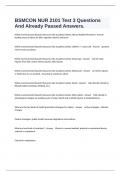BSMCON NUR 2101 Test 3 Questions
And Already Passed Answers.
Define environmental hazards that pose risks to patient safety: Infants/Toddler/Preschool - Answer
leading cause of injury are falls, ingestion injuries and burns
Define environmental hazards that pose risks to patient safety: Children < 5 years old - Answer greatest
risk for home accidents
Define environmental hazards that pose risks to patient safety: School age - Answer risk for head
injuries from falls, motor vehicle injuries, bike injuries
Define environmental hazards that pose risks to patient safety: Adolescent - Answer at risk for injuries
or death due to car accident , drowning or substance abuse
Define environmental hazards that pose risks to patient safety: Adults - Answer risks directly related to
lifestyle habits (smoking, drinking, etc.)
Define environmental hazards that pose risks to patient safety: Older adults - Answer Falls related to
physiological changes are leading cause of injury death and nonfatal injuries & hospitalizations
What are the two kinds of health promotion strategies for safety? - Answer Active strategies = lifestyle
changes
Passive strategies= public health measures/legislative interventions
What are two kinds of restraints? - Answer Physical = manual method, physical or mechanical device,
material or equipment
Chemical= medications
, Identify links of the infection chain - Answer infectious agent, reservoir, portal of exit, transmission,
portal of entry, host susceptibility
What are the two kinds of common reservoirs? - Answer hosts = humans/animals
fomites= insects, food, water, etc
What are the 5 kinds of transmission? - Answer direct contact, indirect transmission, fecal-oral, droplet,
airborne
What factors influence infection prevention and control? - Answer Age, heredity, cultural practices,
nutritional status, stress, rest and exercise, inadequate defenses, personal habits, environmental factors,
immunization/disease history, medical therapies, clinical appearance and data
What are the 5 HAI risk factors? - Answer invasive procedures, medical therapies, long hospitalization,
personnel contact, underlying condition
What are 4 common sites for HAIs? - Answer urinary tract, surgical/traumatic wounds, respiratory
tract, bloodstream
What are the 3 pieces of standard precaution PPEs? - Answer gloves, gowns, masks
When do you use standard precautions? - Answer Always, with every patient regardless of diagnosis if
there is a chance you might come in contact with blood, body fluids, non-intact skin, mucous
membranes or contaminated surfaces
When are transmission precautions used? - Answer in addition to standard precautions for clients with
known nor suspected infections that spread via airborne, droplet or contact transmission
What PPE is required for airborne transmission- based precautions? - Answer mask, gloves and a
special particulate respirator




